Case Study: Kelly, a Pregnant Woman with Multiple Health Issues
VerifiedAdded on 2023/03/17
|8
|3338
|81
Case Study
AI Summary
This case study focuses on Kelly, a 32-year-old pregnant woman in her second trimester, with a history of viral hepatitis and previous pregnancy complications including hyperemesis and sciatica. The essay details the pathophysiology of her conditions, including sciatica caused by nerve compression and hyperemesis, which is characterized by persistent nausea and vomiting. It describes the pharmacokinetics and pharmacodynamics of medications used to manage her symptoms, such as paracetamol for pain, metoclopramide as an antiemetic, and the potential use of ondansetron. The case study explores the effects of her liver dysfunction on drug metabolism and the implications of her treatments, including the potential use of pethidine for pain relief and the management of potential risks to the newborn. The study also addresses the causes of nausea and vomiting in pregnancy and the importance of considering gastrointestinal factors, as well as other medical conditions that can exacerbate the symptoms. The case study aims to understand the complex interplay of conditions and medication effects in the context of pregnancy.
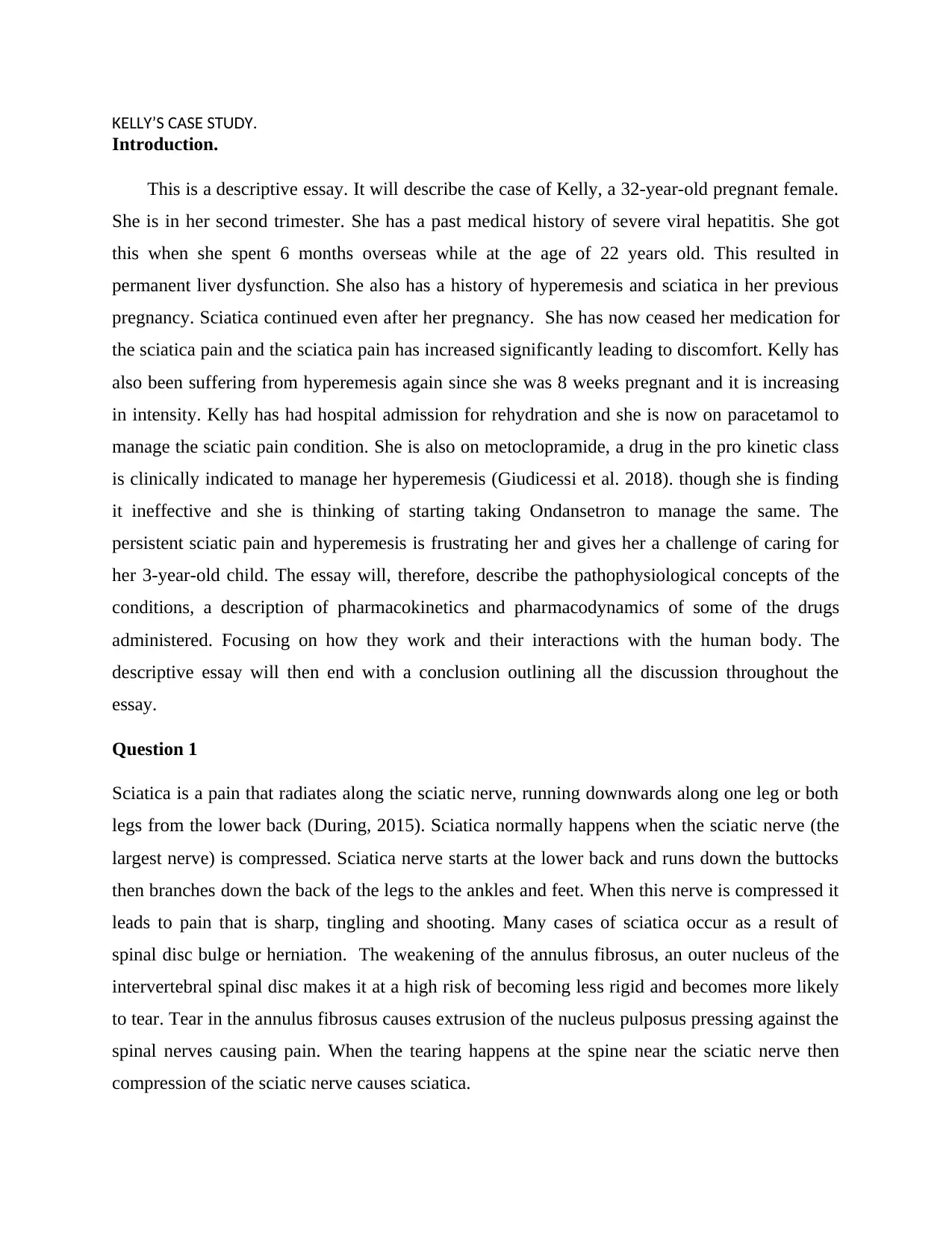
KELLY’S CASE STUDY.
Introduction.
This is a descriptive essay. It will describe the case of Kelly, a 32-year-old pregnant female.
She is in her second trimester. She has a past medical history of severe viral hepatitis. She got
this when she spent 6 months overseas while at the age of 22 years old. This resulted in
permanent liver dysfunction. She also has a history of hyperemesis and sciatica in her previous
pregnancy. Sciatica continued even after her pregnancy. She has now ceased her medication for
the sciatica pain and the sciatica pain has increased significantly leading to discomfort. Kelly has
also been suffering from hyperemesis again since she was 8 weeks pregnant and it is increasing
in intensity. Kelly has had hospital admission for rehydration and she is now on paracetamol to
manage the sciatic pain condition. She is also on metoclopramide, a drug in the pro kinetic class
is clinically indicated to manage her hyperemesis (Giudicessi et al. 2018). though she is finding
it ineffective and she is thinking of starting taking Ondansetron to manage the same. The
persistent sciatic pain and hyperemesis is frustrating her and gives her a challenge of caring for
her 3-year-old child. The essay will, therefore, describe the pathophysiological concepts of the
conditions, a description of pharmacokinetics and pharmacodynamics of some of the drugs
administered. Focusing on how they work and their interactions with the human body. The
descriptive essay will then end with a conclusion outlining all the discussion throughout the
essay.
Question 1
Sciatica is a pain that radiates along the sciatic nerve, running downwards along one leg or both
legs from the lower back (During, 2015). Sciatica normally happens when the sciatic nerve (the
largest nerve) is compressed. Sciatica nerve starts at the lower back and runs down the buttocks
then branches down the back of the legs to the ankles and feet. When this nerve is compressed it
leads to pain that is sharp, tingling and shooting. Many cases of sciatica occur as a result of
spinal disc bulge or herniation. The weakening of the annulus fibrosus, an outer nucleus of the
intervertebral spinal disc makes it at a high risk of becoming less rigid and becomes more likely
to tear. Tear in the annulus fibrosus causes extrusion of the nucleus pulposus pressing against the
spinal nerves causing pain. When the tearing happens at the spine near the sciatic nerve then
compression of the sciatic nerve causes sciatica.
Introduction.
This is a descriptive essay. It will describe the case of Kelly, a 32-year-old pregnant female.
She is in her second trimester. She has a past medical history of severe viral hepatitis. She got
this when she spent 6 months overseas while at the age of 22 years old. This resulted in
permanent liver dysfunction. She also has a history of hyperemesis and sciatica in her previous
pregnancy. Sciatica continued even after her pregnancy. She has now ceased her medication for
the sciatica pain and the sciatica pain has increased significantly leading to discomfort. Kelly has
also been suffering from hyperemesis again since she was 8 weeks pregnant and it is increasing
in intensity. Kelly has had hospital admission for rehydration and she is now on paracetamol to
manage the sciatic pain condition. She is also on metoclopramide, a drug in the pro kinetic class
is clinically indicated to manage her hyperemesis (Giudicessi et al. 2018). though she is finding
it ineffective and she is thinking of starting taking Ondansetron to manage the same. The
persistent sciatic pain and hyperemesis is frustrating her and gives her a challenge of caring for
her 3-year-old child. The essay will, therefore, describe the pathophysiological concepts of the
conditions, a description of pharmacokinetics and pharmacodynamics of some of the drugs
administered. Focusing on how they work and their interactions with the human body. The
descriptive essay will then end with a conclusion outlining all the discussion throughout the
essay.
Question 1
Sciatica is a pain that radiates along the sciatic nerve, running downwards along one leg or both
legs from the lower back (During, 2015). Sciatica normally happens when the sciatic nerve (the
largest nerve) is compressed. Sciatica nerve starts at the lower back and runs down the buttocks
then branches down the back of the legs to the ankles and feet. When this nerve is compressed it
leads to pain that is sharp, tingling and shooting. Many cases of sciatica occur as a result of
spinal disc bulge or herniation. The weakening of the annulus fibrosus, an outer nucleus of the
intervertebral spinal disc makes it at a high risk of becoming less rigid and becomes more likely
to tear. Tear in the annulus fibrosus causes extrusion of the nucleus pulposus pressing against the
spinal nerves causing pain. When the tearing happens at the spine near the sciatic nerve then
compression of the sciatic nerve causes sciatica.
Paraphrase This Document
Need a fresh take? Get an instant paraphrase of this document with our AI Paraphraser
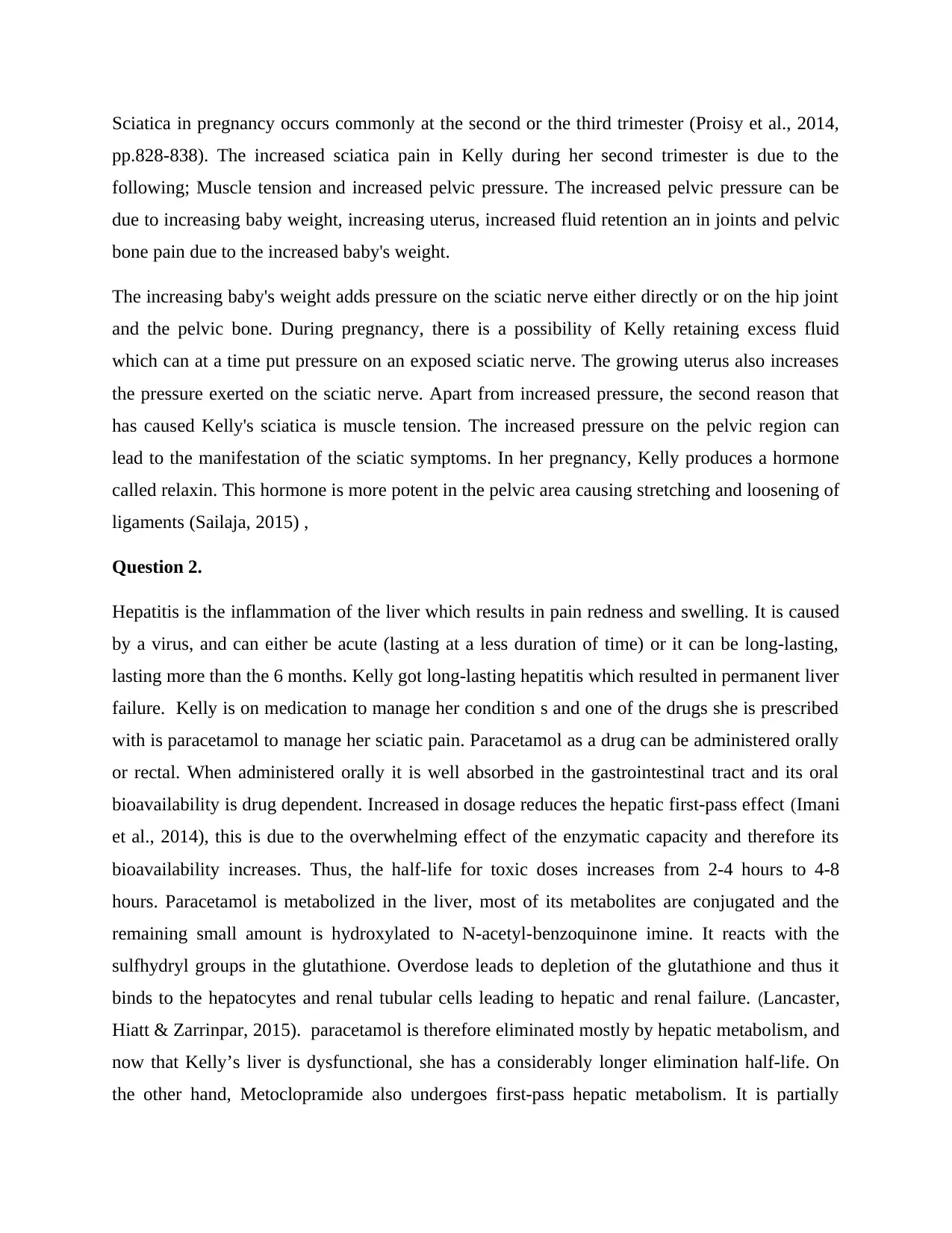
Sciatica in pregnancy occurs commonly at the second or the third trimester (Proisy et al., 2014,
pp.828-838). The increased sciatica pain in Kelly during her second trimester is due to the
following; Muscle tension and increased pelvic pressure. The increased pelvic pressure can be
due to increasing baby weight, increasing uterus, increased fluid retention an in joints and pelvic
bone pain due to the increased baby's weight.
The increasing baby's weight adds pressure on the sciatic nerve either directly or on the hip joint
and the pelvic bone. During pregnancy, there is a possibility of Kelly retaining excess fluid
which can at a time put pressure on an exposed sciatic nerve. The growing uterus also increases
the pressure exerted on the sciatic nerve. Apart from increased pressure, the second reason that
has caused Kelly's sciatica is muscle tension. The increased pressure on the pelvic region can
lead to the manifestation of the sciatic symptoms. In her pregnancy, Kelly produces a hormone
called relaxin. This hormone is more potent in the pelvic area causing stretching and loosening of
ligaments (Sailaja, 2015) ,
Question 2.
Hepatitis is the inflammation of the liver which results in pain redness and swelling. It is caused
by a virus, and can either be acute (lasting at a less duration of time) or it can be long-lasting,
lasting more than the 6 months. Kelly got long-lasting hepatitis which resulted in permanent liver
failure. Kelly is on medication to manage her condition s and one of the drugs she is prescribed
with is paracetamol to manage her sciatic pain. Paracetamol as a drug can be administered orally
or rectal. When administered orally it is well absorbed in the gastrointestinal tract and its oral
bioavailability is drug dependent. Increased in dosage reduces the hepatic first-pass effect (Imani
et al., 2014), this is due to the overwhelming effect of the enzymatic capacity and therefore its
bioavailability increases. Thus, the half-life for toxic doses increases from 2-4 hours to 4-8
hours. Paracetamol is metabolized in the liver, most of its metabolites are conjugated and the
remaining small amount is hydroxylated to N-acetyl-benzoquinone imine. It reacts with the
sulfhydryl groups in the glutathione. Overdose leads to depletion of the glutathione and thus it
binds to the hepatocytes and renal tubular cells leading to hepatic and renal failure. (Lancaster,
Hiatt & Zarrinpar, 2015). paracetamol is therefore eliminated mostly by hepatic metabolism, and
now that Kelly’s liver is dysfunctional, she has a considerably longer elimination half-life. On
the other hand, Metoclopramide also undergoes first-pass hepatic metabolism. It is partially
pp.828-838). The increased sciatica pain in Kelly during her second trimester is due to the
following; Muscle tension and increased pelvic pressure. The increased pelvic pressure can be
due to increasing baby weight, increasing uterus, increased fluid retention an in joints and pelvic
bone pain due to the increased baby's weight.
The increasing baby's weight adds pressure on the sciatic nerve either directly or on the hip joint
and the pelvic bone. During pregnancy, there is a possibility of Kelly retaining excess fluid
which can at a time put pressure on an exposed sciatic nerve. The growing uterus also increases
the pressure exerted on the sciatic nerve. Apart from increased pressure, the second reason that
has caused Kelly's sciatica is muscle tension. The increased pressure on the pelvic region can
lead to the manifestation of the sciatic symptoms. In her pregnancy, Kelly produces a hormone
called relaxin. This hormone is more potent in the pelvic area causing stretching and loosening of
ligaments (Sailaja, 2015) ,
Question 2.
Hepatitis is the inflammation of the liver which results in pain redness and swelling. It is caused
by a virus, and can either be acute (lasting at a less duration of time) or it can be long-lasting,
lasting more than the 6 months. Kelly got long-lasting hepatitis which resulted in permanent liver
failure. Kelly is on medication to manage her condition s and one of the drugs she is prescribed
with is paracetamol to manage her sciatic pain. Paracetamol as a drug can be administered orally
or rectal. When administered orally it is well absorbed in the gastrointestinal tract and its oral
bioavailability is drug dependent. Increased in dosage reduces the hepatic first-pass effect (Imani
et al., 2014), this is due to the overwhelming effect of the enzymatic capacity and therefore its
bioavailability increases. Thus, the half-life for toxic doses increases from 2-4 hours to 4-8
hours. Paracetamol is metabolized in the liver, most of its metabolites are conjugated and the
remaining small amount is hydroxylated to N-acetyl-benzoquinone imine. It reacts with the
sulfhydryl groups in the glutathione. Overdose leads to depletion of the glutathione and thus it
binds to the hepatocytes and renal tubular cells leading to hepatic and renal failure. (Lancaster,
Hiatt & Zarrinpar, 2015). paracetamol is therefore eliminated mostly by hepatic metabolism, and
now that Kelly’s liver is dysfunctional, she has a considerably longer elimination half-life. On
the other hand, Metoclopramide also undergoes first-pass hepatic metabolism. It is partially
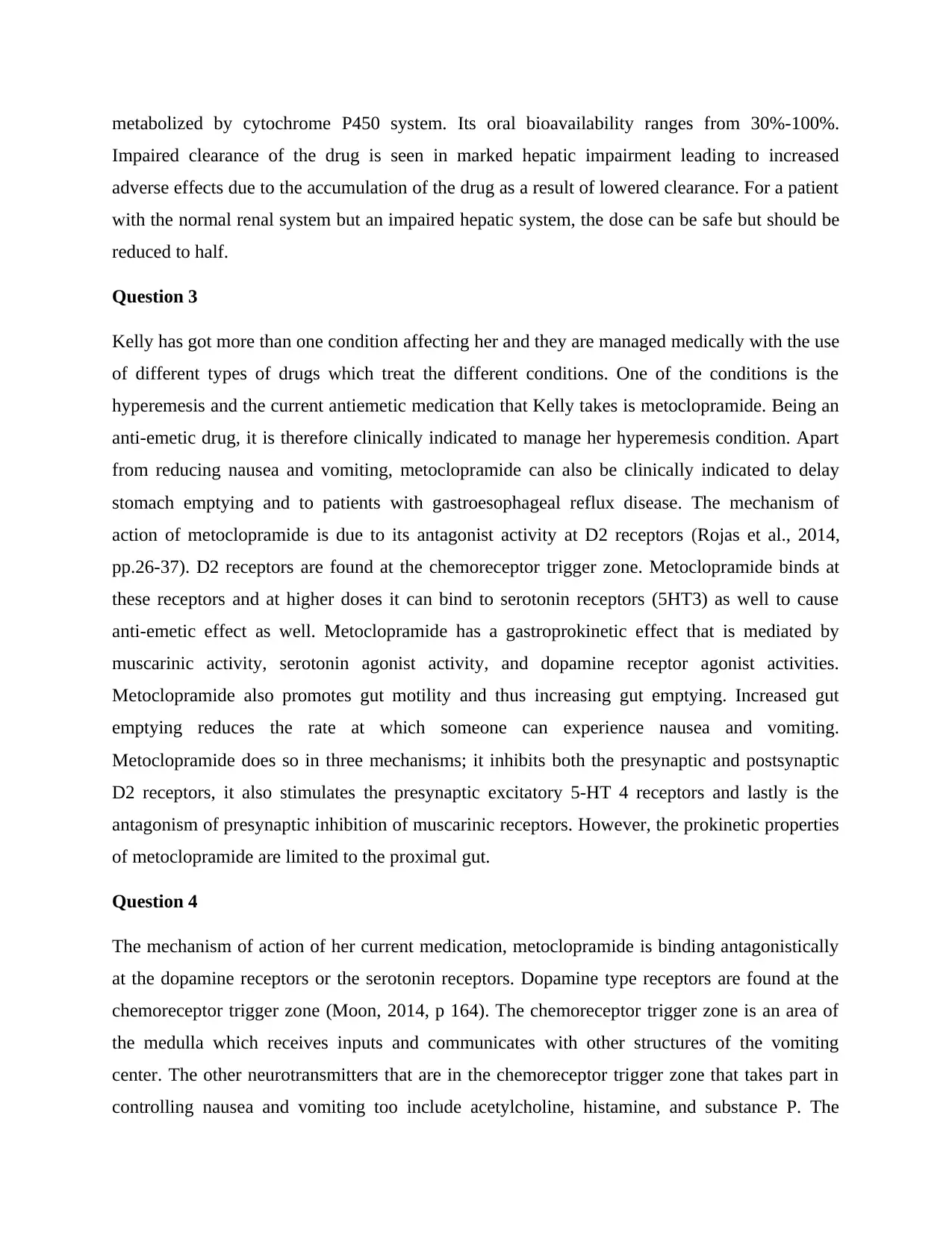
metabolized by cytochrome P450 system. Its oral bioavailability ranges from 30%-100%.
Impaired clearance of the drug is seen in marked hepatic impairment leading to increased
adverse effects due to the accumulation of the drug as a result of lowered clearance. For a patient
with the normal renal system but an impaired hepatic system, the dose can be safe but should be
reduced to half.
Question 3
Kelly has got more than one condition affecting her and they are managed medically with the use
of different types of drugs which treat the different conditions. One of the conditions is the
hyperemesis and the current antiemetic medication that Kelly takes is metoclopramide. Being an
anti-emetic drug, it is therefore clinically indicated to manage her hyperemesis condition. Apart
from reducing nausea and vomiting, metoclopramide can also be clinically indicated to delay
stomach emptying and to patients with gastroesophageal reflux disease. The mechanism of
action of metoclopramide is due to its antagonist activity at D2 receptors (Rojas et al., 2014,
pp.26-37). D2 receptors are found at the chemoreceptor trigger zone. Metoclopramide binds at
these receptors and at higher doses it can bind to serotonin receptors (5HT3) as well to cause
anti-emetic effect as well. Metoclopramide has a gastroprokinetic effect that is mediated by
muscarinic activity, serotonin agonist activity, and dopamine receptor agonist activities.
Metoclopramide also promotes gut motility and thus increasing gut emptying. Increased gut
emptying reduces the rate at which someone can experience nausea and vomiting.
Metoclopramide does so in three mechanisms; it inhibits both the presynaptic and postsynaptic
D2 receptors, it also stimulates the presynaptic excitatory 5-HT 4 receptors and lastly is the
antagonism of presynaptic inhibition of muscarinic receptors. However, the prokinetic properties
of metoclopramide are limited to the proximal gut.
Question 4
The mechanism of action of her current medication, metoclopramide is binding antagonistically
at the dopamine receptors or the serotonin receptors. Dopamine type receptors are found at the
chemoreceptor trigger zone (Moon, 2014, p 164). The chemoreceptor trigger zone is an area of
the medulla which receives inputs and communicates with other structures of the vomiting
center. The other neurotransmitters that are in the chemoreceptor trigger zone that takes part in
controlling nausea and vomiting too include acetylcholine, histamine, and substance P. The
Impaired clearance of the drug is seen in marked hepatic impairment leading to increased
adverse effects due to the accumulation of the drug as a result of lowered clearance. For a patient
with the normal renal system but an impaired hepatic system, the dose can be safe but should be
reduced to half.
Question 3
Kelly has got more than one condition affecting her and they are managed medically with the use
of different types of drugs which treat the different conditions. One of the conditions is the
hyperemesis and the current antiemetic medication that Kelly takes is metoclopramide. Being an
anti-emetic drug, it is therefore clinically indicated to manage her hyperemesis condition. Apart
from reducing nausea and vomiting, metoclopramide can also be clinically indicated to delay
stomach emptying and to patients with gastroesophageal reflux disease. The mechanism of
action of metoclopramide is due to its antagonist activity at D2 receptors (Rojas et al., 2014,
pp.26-37). D2 receptors are found at the chemoreceptor trigger zone. Metoclopramide binds at
these receptors and at higher doses it can bind to serotonin receptors (5HT3) as well to cause
anti-emetic effect as well. Metoclopramide has a gastroprokinetic effect that is mediated by
muscarinic activity, serotonin agonist activity, and dopamine receptor agonist activities.
Metoclopramide also promotes gut motility and thus increasing gut emptying. Increased gut
emptying reduces the rate at which someone can experience nausea and vomiting.
Metoclopramide does so in three mechanisms; it inhibits both the presynaptic and postsynaptic
D2 receptors, it also stimulates the presynaptic excitatory 5-HT 4 receptors and lastly is the
antagonism of presynaptic inhibition of muscarinic receptors. However, the prokinetic properties
of metoclopramide are limited to the proximal gut.
Question 4
The mechanism of action of her current medication, metoclopramide is binding antagonistically
at the dopamine receptors or the serotonin receptors. Dopamine type receptors are found at the
chemoreceptor trigger zone (Moon, 2014, p 164). The chemoreceptor trigger zone is an area of
the medulla which receives inputs and communicates with other structures of the vomiting
center. The other neurotransmitters that are in the chemoreceptor trigger zone that takes part in
controlling nausea and vomiting too include acetylcholine, histamine, and substance P. The
⊘ This is a preview!⊘
Do you want full access?
Subscribe today to unlock all pages.

Trusted by 1+ million students worldwide
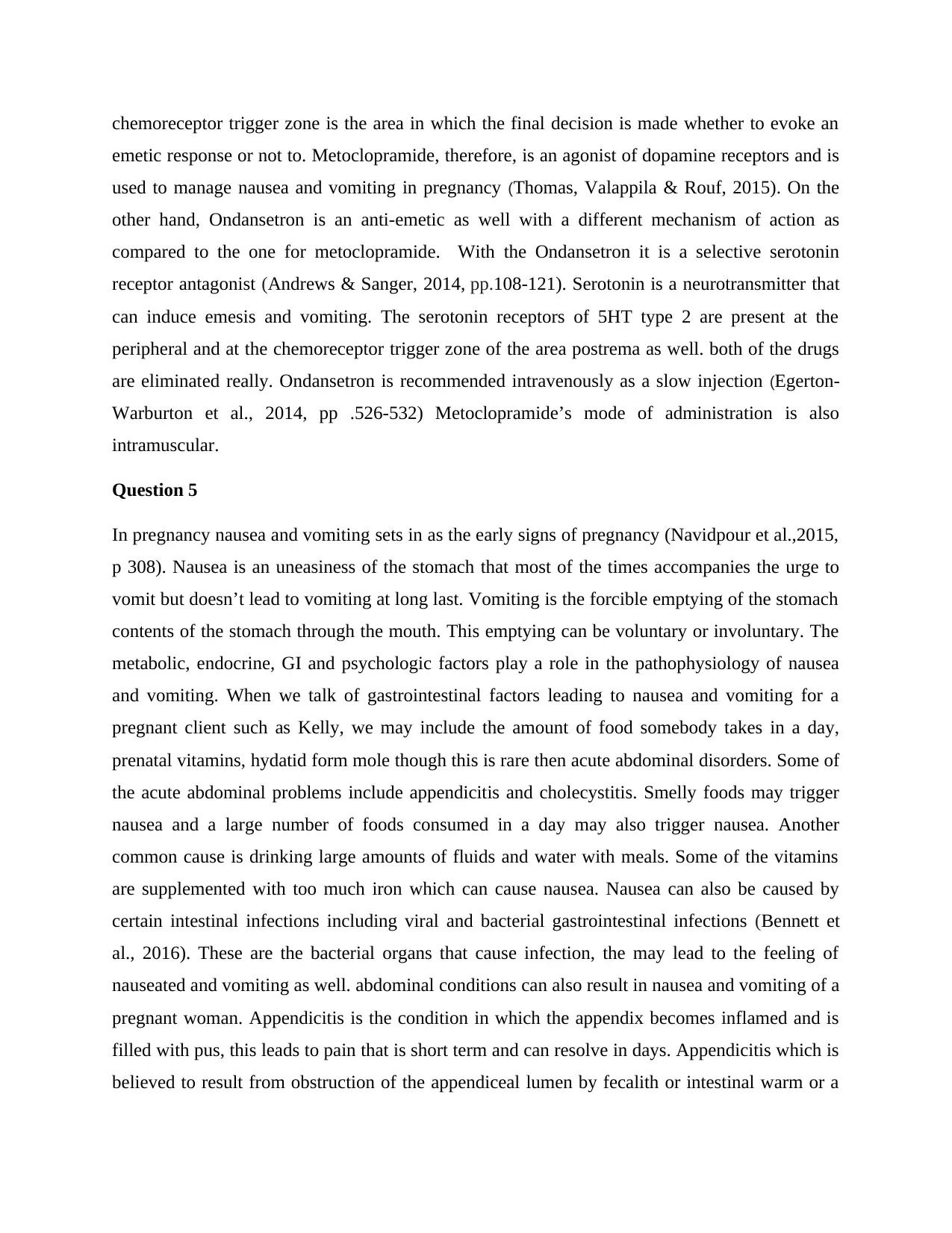
chemoreceptor trigger zone is the area in which the final decision is made whether to evoke an
emetic response or not to. Metoclopramide, therefore, is an agonist of dopamine receptors and is
used to manage nausea and vomiting in pregnancy (Thomas, Valappila & Rouf, 2015). On the
other hand, Ondansetron is an anti-emetic as well with a different mechanism of action as
compared to the one for metoclopramide. With the Ondansetron it is a selective serotonin
receptor antagonist (Andrews & Sanger, 2014, pp.108-121). Serotonin is a neurotransmitter that
can induce emesis and vomiting. The serotonin receptors of 5HT type 2 are present at the
peripheral and at the chemoreceptor trigger zone of the area postrema as well. both of the drugs
are eliminated really. Ondansetron is recommended intravenously as a slow injection (Egerton-
Warburton et al., 2014, pp .526-532) Metoclopramide’s mode of administration is also
intramuscular.
Question 5
In pregnancy nausea and vomiting sets in as the early signs of pregnancy (Navidpour et al.,2015,
p 308). Nausea is an uneasiness of the stomach that most of the times accompanies the urge to
vomit but doesn’t lead to vomiting at long last. Vomiting is the forcible emptying of the stomach
contents of the stomach through the mouth. This emptying can be voluntary or involuntary. The
metabolic, endocrine, GI and psychologic factors play a role in the pathophysiology of nausea
and vomiting. When we talk of gastrointestinal factors leading to nausea and vomiting for a
pregnant client such as Kelly, we may include the amount of food somebody takes in a day,
prenatal vitamins, hydatid form mole though this is rare then acute abdominal disorders. Some of
the acute abdominal problems include appendicitis and cholecystitis. Smelly foods may trigger
nausea and a large number of foods consumed in a day may also trigger nausea. Another
common cause is drinking large amounts of fluids and water with meals. Some of the vitamins
are supplemented with too much iron which can cause nausea. Nausea can also be caused by
certain intestinal infections including viral and bacterial gastrointestinal infections (Bennett et
al., 2016). These are the bacterial organs that cause infection, the may lead to the feeling of
nauseated and vomiting as well. abdominal conditions can also result in nausea and vomiting of a
pregnant woman. Appendicitis is the condition in which the appendix becomes inflamed and is
filled with pus, this leads to pain that is short term and can resolve in days. Appendicitis which is
believed to result from obstruction of the appendiceal lumen by fecalith or intestinal warm or a
emetic response or not to. Metoclopramide, therefore, is an agonist of dopamine receptors and is
used to manage nausea and vomiting in pregnancy (Thomas, Valappila & Rouf, 2015). On the
other hand, Ondansetron is an anti-emetic as well with a different mechanism of action as
compared to the one for metoclopramide. With the Ondansetron it is a selective serotonin
receptor antagonist (Andrews & Sanger, 2014, pp.108-121). Serotonin is a neurotransmitter that
can induce emesis and vomiting. The serotonin receptors of 5HT type 2 are present at the
peripheral and at the chemoreceptor trigger zone of the area postrema as well. both of the drugs
are eliminated really. Ondansetron is recommended intravenously as a slow injection (Egerton-
Warburton et al., 2014, pp .526-532) Metoclopramide’s mode of administration is also
intramuscular.
Question 5
In pregnancy nausea and vomiting sets in as the early signs of pregnancy (Navidpour et al.,2015,
p 308). Nausea is an uneasiness of the stomach that most of the times accompanies the urge to
vomit but doesn’t lead to vomiting at long last. Vomiting is the forcible emptying of the stomach
contents of the stomach through the mouth. This emptying can be voluntary or involuntary. The
metabolic, endocrine, GI and psychologic factors play a role in the pathophysiology of nausea
and vomiting. When we talk of gastrointestinal factors leading to nausea and vomiting for a
pregnant client such as Kelly, we may include the amount of food somebody takes in a day,
prenatal vitamins, hydatid form mole though this is rare then acute abdominal disorders. Some of
the acute abdominal problems include appendicitis and cholecystitis. Smelly foods may trigger
nausea and a large number of foods consumed in a day may also trigger nausea. Another
common cause is drinking large amounts of fluids and water with meals. Some of the vitamins
are supplemented with too much iron which can cause nausea. Nausea can also be caused by
certain intestinal infections including viral and bacterial gastrointestinal infections (Bennett et
al., 2016). These are the bacterial organs that cause infection, the may lead to the feeling of
nauseated and vomiting as well. abdominal conditions can also result in nausea and vomiting of a
pregnant woman. Appendicitis is the condition in which the appendix becomes inflamed and is
filled with pus, this leads to pain that is short term and can resolve in days. Appendicitis which is
believed to result from obstruction of the appendiceal lumen by fecalith or intestinal warm or a
Paraphrase This Document
Need a fresh take? Get an instant paraphrase of this document with our AI Paraphraser
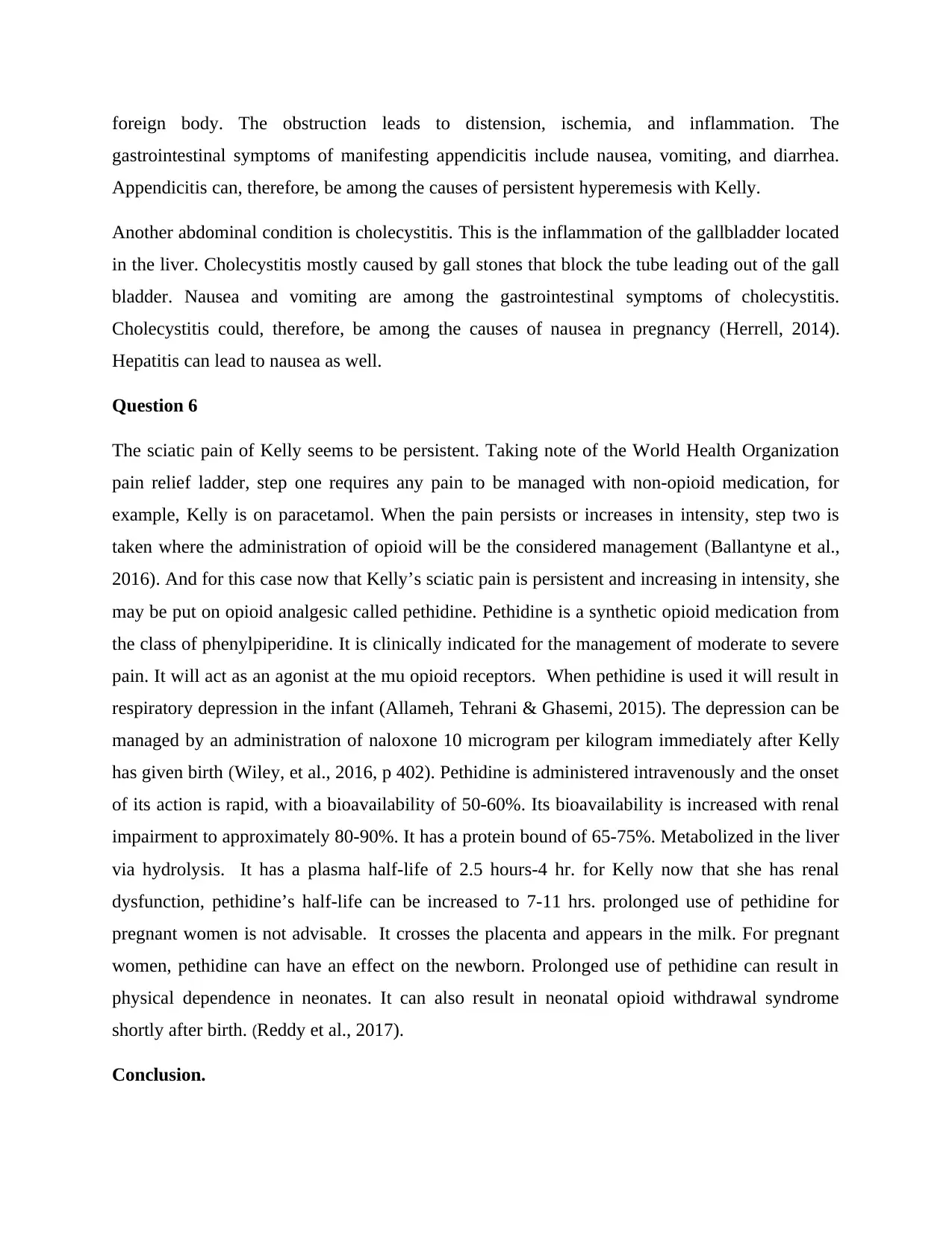
foreign body. The obstruction leads to distension, ischemia, and inflammation. The
gastrointestinal symptoms of manifesting appendicitis include nausea, vomiting, and diarrhea.
Appendicitis can, therefore, be among the causes of persistent hyperemesis with Kelly.
Another abdominal condition is cholecystitis. This is the inflammation of the gallbladder located
in the liver. Cholecystitis mostly caused by gall stones that block the tube leading out of the gall
bladder. Nausea and vomiting are among the gastrointestinal symptoms of cholecystitis.
Cholecystitis could, therefore, be among the causes of nausea in pregnancy (Herrell, 2014).
Hepatitis can lead to nausea as well.
Question 6
The sciatic pain of Kelly seems to be persistent. Taking note of the World Health Organization
pain relief ladder, step one requires any pain to be managed with non-opioid medication, for
example, Kelly is on paracetamol. When the pain persists or increases in intensity, step two is
taken where the administration of opioid will be the considered management (Ballantyne et al.,
2016). And for this case now that Kelly’s sciatic pain is persistent and increasing in intensity, she
may be put on opioid analgesic called pethidine. Pethidine is a synthetic opioid medication from
the class of phenylpiperidine. It is clinically indicated for the management of moderate to severe
pain. It will act as an agonist at the mu opioid receptors. When pethidine is used it will result in
respiratory depression in the infant (Allameh, Tehrani & Ghasemi, 2015). The depression can be
managed by an administration of naloxone 10 microgram per kilogram immediately after Kelly
has given birth (Wiley, et al., 2016, p 402). Pethidine is administered intravenously and the onset
of its action is rapid, with a bioavailability of 50-60%. Its bioavailability is increased with renal
impairment to approximately 80-90%. It has a protein bound of 65-75%. Metabolized in the liver
via hydrolysis. It has a plasma half-life of 2.5 hours-4 hr. for Kelly now that she has renal
dysfunction, pethidine’s half-life can be increased to 7-11 hrs. prolonged use of pethidine for
pregnant women is not advisable. It crosses the placenta and appears in the milk. For pregnant
women, pethidine can have an effect on the newborn. Prolonged use of pethidine can result in
physical dependence in neonates. It can also result in neonatal opioid withdrawal syndrome
shortly after birth. (Reddy et al., 2017).
Conclusion.
gastrointestinal symptoms of manifesting appendicitis include nausea, vomiting, and diarrhea.
Appendicitis can, therefore, be among the causes of persistent hyperemesis with Kelly.
Another abdominal condition is cholecystitis. This is the inflammation of the gallbladder located
in the liver. Cholecystitis mostly caused by gall stones that block the tube leading out of the gall
bladder. Nausea and vomiting are among the gastrointestinal symptoms of cholecystitis.
Cholecystitis could, therefore, be among the causes of nausea in pregnancy (Herrell, 2014).
Hepatitis can lead to nausea as well.
Question 6
The sciatic pain of Kelly seems to be persistent. Taking note of the World Health Organization
pain relief ladder, step one requires any pain to be managed with non-opioid medication, for
example, Kelly is on paracetamol. When the pain persists or increases in intensity, step two is
taken where the administration of opioid will be the considered management (Ballantyne et al.,
2016). And for this case now that Kelly’s sciatic pain is persistent and increasing in intensity, she
may be put on opioid analgesic called pethidine. Pethidine is a synthetic opioid medication from
the class of phenylpiperidine. It is clinically indicated for the management of moderate to severe
pain. It will act as an agonist at the mu opioid receptors. When pethidine is used it will result in
respiratory depression in the infant (Allameh, Tehrani & Ghasemi, 2015). The depression can be
managed by an administration of naloxone 10 microgram per kilogram immediately after Kelly
has given birth (Wiley, et al., 2016, p 402). Pethidine is administered intravenously and the onset
of its action is rapid, with a bioavailability of 50-60%. Its bioavailability is increased with renal
impairment to approximately 80-90%. It has a protein bound of 65-75%. Metabolized in the liver
via hydrolysis. It has a plasma half-life of 2.5 hours-4 hr. for Kelly now that she has renal
dysfunction, pethidine’s half-life can be increased to 7-11 hrs. prolonged use of pethidine for
pregnant women is not advisable. It crosses the placenta and appears in the milk. For pregnant
women, pethidine can have an effect on the newborn. Prolonged use of pethidine can result in
physical dependence in neonates. It can also result in neonatal opioid withdrawal syndrome
shortly after birth. (Reddy et al., 2017).
Conclusion.
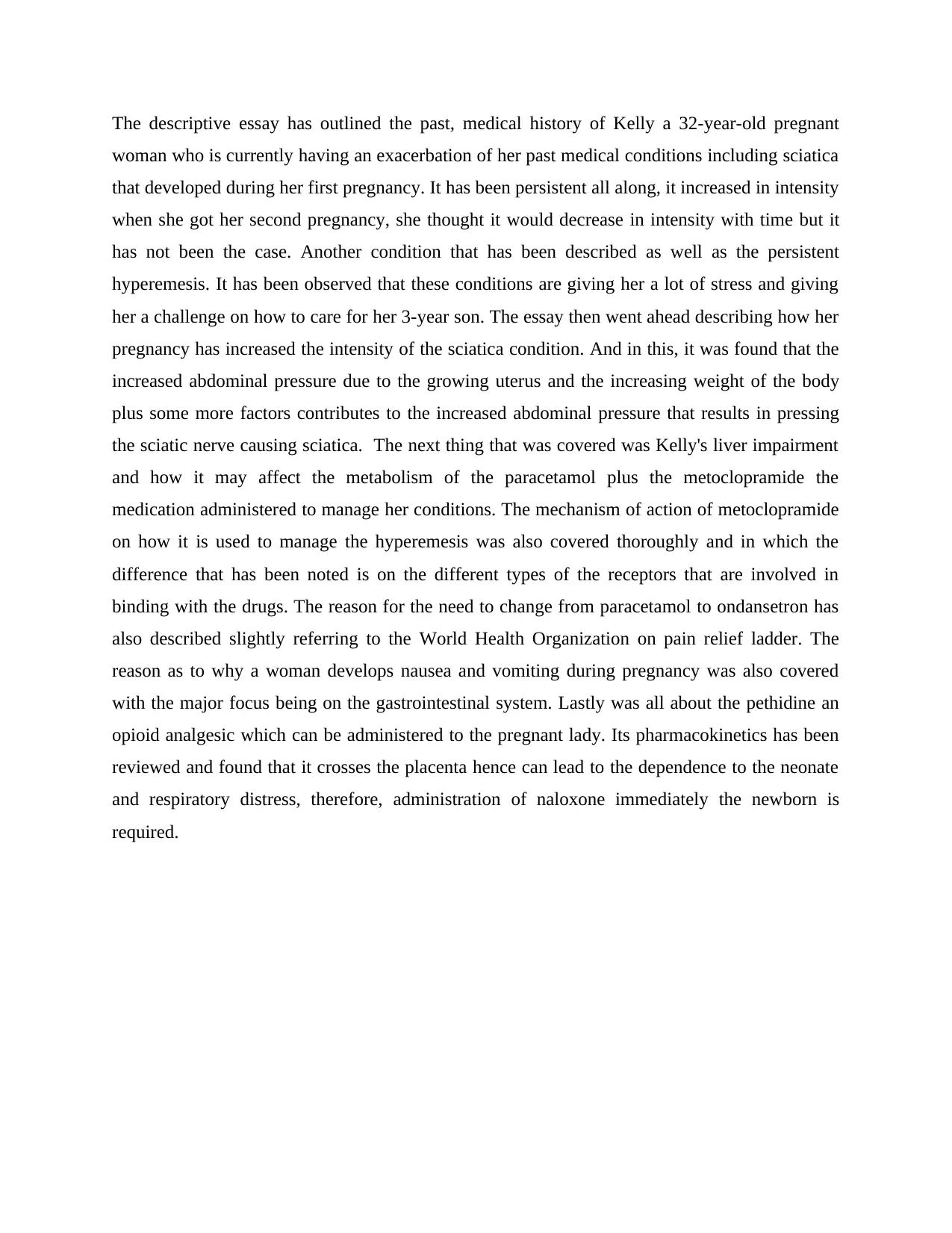
The descriptive essay has outlined the past, medical history of Kelly a 32-year-old pregnant
woman who is currently having an exacerbation of her past medical conditions including sciatica
that developed during her first pregnancy. It has been persistent all along, it increased in intensity
when she got her second pregnancy, she thought it would decrease in intensity with time but it
has not been the case. Another condition that has been described as well as the persistent
hyperemesis. It has been observed that these conditions are giving her a lot of stress and giving
her a challenge on how to care for her 3-year son. The essay then went ahead describing how her
pregnancy has increased the intensity of the sciatica condition. And in this, it was found that the
increased abdominal pressure due to the growing uterus and the increasing weight of the body
plus some more factors contributes to the increased abdominal pressure that results in pressing
the sciatic nerve causing sciatica. The next thing that was covered was Kelly's liver impairment
and how it may affect the metabolism of the paracetamol plus the metoclopramide the
medication administered to manage her conditions. The mechanism of action of metoclopramide
on how it is used to manage the hyperemesis was also covered thoroughly and in which the
difference that has been noted is on the different types of the receptors that are involved in
binding with the drugs. The reason for the need to change from paracetamol to ondansetron has
also described slightly referring to the World Health Organization on pain relief ladder. The
reason as to why a woman develops nausea and vomiting during pregnancy was also covered
with the major focus being on the gastrointestinal system. Lastly was all about the pethidine an
opioid analgesic which can be administered to the pregnant lady. Its pharmacokinetics has been
reviewed and found that it crosses the placenta hence can lead to the dependence to the neonate
and respiratory distress, therefore, administration of naloxone immediately the newborn is
required.
woman who is currently having an exacerbation of her past medical conditions including sciatica
that developed during her first pregnancy. It has been persistent all along, it increased in intensity
when she got her second pregnancy, she thought it would decrease in intensity with time but it
has not been the case. Another condition that has been described as well as the persistent
hyperemesis. It has been observed that these conditions are giving her a lot of stress and giving
her a challenge on how to care for her 3-year son. The essay then went ahead describing how her
pregnancy has increased the intensity of the sciatica condition. And in this, it was found that the
increased abdominal pressure due to the growing uterus and the increasing weight of the body
plus some more factors contributes to the increased abdominal pressure that results in pressing
the sciatic nerve causing sciatica. The next thing that was covered was Kelly's liver impairment
and how it may affect the metabolism of the paracetamol plus the metoclopramide the
medication administered to manage her conditions. The mechanism of action of metoclopramide
on how it is used to manage the hyperemesis was also covered thoroughly and in which the
difference that has been noted is on the different types of the receptors that are involved in
binding with the drugs. The reason for the need to change from paracetamol to ondansetron has
also described slightly referring to the World Health Organization on pain relief ladder. The
reason as to why a woman develops nausea and vomiting during pregnancy was also covered
with the major focus being on the gastrointestinal system. Lastly was all about the pethidine an
opioid analgesic which can be administered to the pregnant lady. Its pharmacokinetics has been
reviewed and found that it crosses the placenta hence can lead to the dependence to the neonate
and respiratory distress, therefore, administration of naloxone immediately the newborn is
required.
⊘ This is a preview!⊘
Do you want full access?
Subscribe today to unlock all pages.

Trusted by 1+ million students worldwide
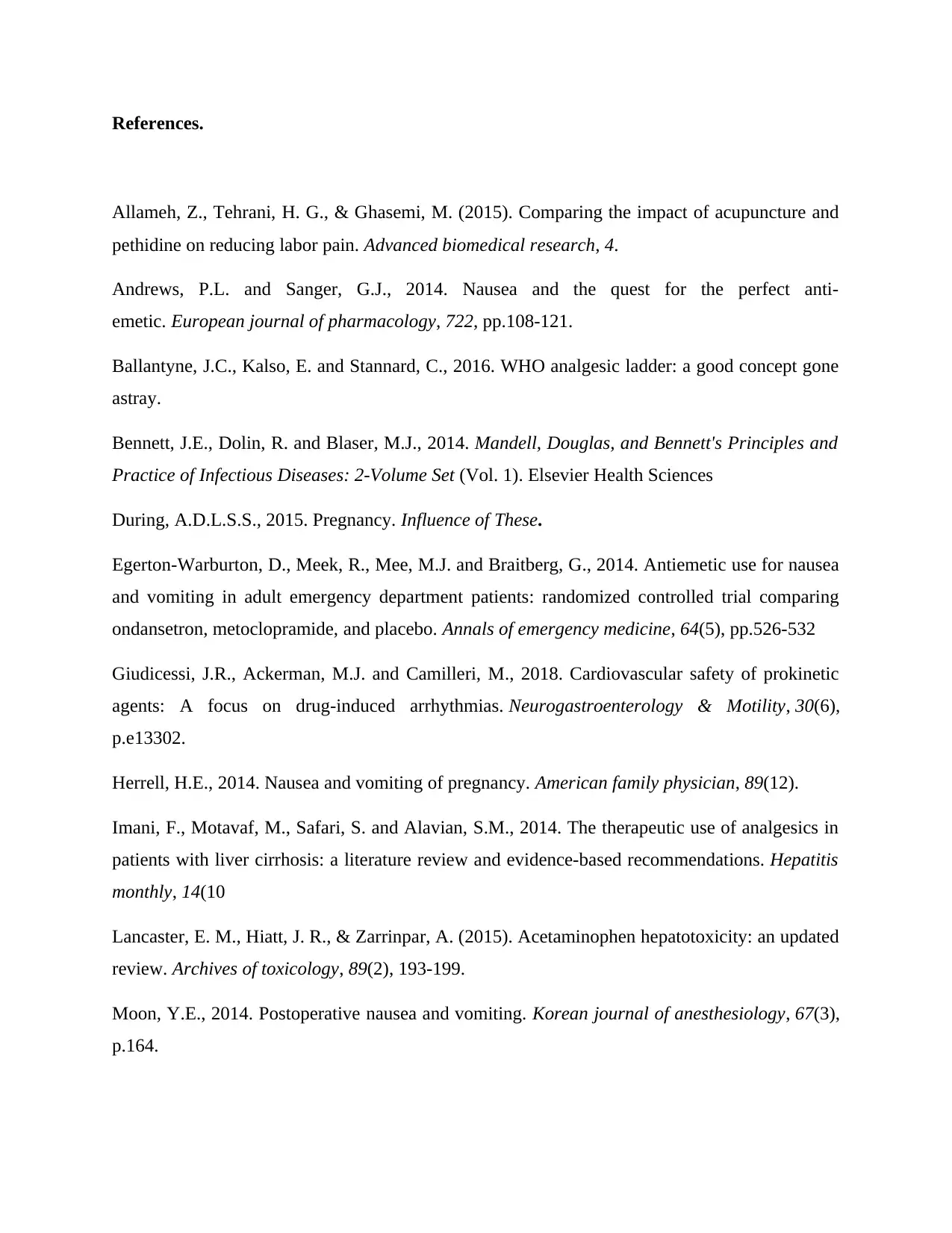
References.
Allameh, Z., Tehrani, H. G., & Ghasemi, M. (2015). Comparing the impact of acupuncture and
pethidine on reducing labor pain. Advanced biomedical research, 4.
Andrews, P.L. and Sanger, G.J., 2014. Nausea and the quest for the perfect anti-
emetic. European journal of pharmacology, 722, pp.108-121.
Ballantyne, J.C., Kalso, E. and Stannard, C., 2016. WHO analgesic ladder: a good concept gone
astray.
Bennett, J.E., Dolin, R. and Blaser, M.J., 2014. Mandell, Douglas, and Bennett's Principles and
Practice of Infectious Diseases: 2-Volume Set (Vol. 1). Elsevier Health Sciences
During, A.D.L.S.S., 2015. Pregnancy. Influence of These.
Egerton-Warburton, D., Meek, R., Mee, M.J. and Braitberg, G., 2014. Antiemetic use for nausea
and vomiting in adult emergency department patients: randomized controlled trial comparing
ondansetron, metoclopramide, and placebo. Annals of emergency medicine, 64(5), pp.526-532
Giudicessi, J.R., Ackerman, M.J. and Camilleri, M., 2018. Cardiovascular safety of prokinetic
agents: A focus on drug‐induced arrhythmias. Neurogastroenterology & Motility, 30(6),
p.e13302.
Herrell, H.E., 2014. Nausea and vomiting of pregnancy. American family physician, 89(12).
Imani, F., Motavaf, M., Safari, S. and Alavian, S.M., 2014. The therapeutic use of analgesics in
patients with liver cirrhosis: a literature review and evidence-based recommendations. Hepatitis
monthly, 14(10
Lancaster, E. M., Hiatt, J. R., & Zarrinpar, A. (2015). Acetaminophen hepatotoxicity: an updated
review. Archives of toxicology, 89(2), 193-199.
Moon, Y.E., 2014. Postoperative nausea and vomiting. Korean journal of anesthesiology, 67(3),
p.164.
Allameh, Z., Tehrani, H. G., & Ghasemi, M. (2015). Comparing the impact of acupuncture and
pethidine on reducing labor pain. Advanced biomedical research, 4.
Andrews, P.L. and Sanger, G.J., 2014. Nausea and the quest for the perfect anti-
emetic. European journal of pharmacology, 722, pp.108-121.
Ballantyne, J.C., Kalso, E. and Stannard, C., 2016. WHO analgesic ladder: a good concept gone
astray.
Bennett, J.E., Dolin, R. and Blaser, M.J., 2014. Mandell, Douglas, and Bennett's Principles and
Practice of Infectious Diseases: 2-Volume Set (Vol. 1). Elsevier Health Sciences
During, A.D.L.S.S., 2015. Pregnancy. Influence of These.
Egerton-Warburton, D., Meek, R., Mee, M.J. and Braitberg, G., 2014. Antiemetic use for nausea
and vomiting in adult emergency department patients: randomized controlled trial comparing
ondansetron, metoclopramide, and placebo. Annals of emergency medicine, 64(5), pp.526-532
Giudicessi, J.R., Ackerman, M.J. and Camilleri, M., 2018. Cardiovascular safety of prokinetic
agents: A focus on drug‐induced arrhythmias. Neurogastroenterology & Motility, 30(6),
p.e13302.
Herrell, H.E., 2014. Nausea and vomiting of pregnancy. American family physician, 89(12).
Imani, F., Motavaf, M., Safari, S. and Alavian, S.M., 2014. The therapeutic use of analgesics in
patients with liver cirrhosis: a literature review and evidence-based recommendations. Hepatitis
monthly, 14(10
Lancaster, E. M., Hiatt, J. R., & Zarrinpar, A. (2015). Acetaminophen hepatotoxicity: an updated
review. Archives of toxicology, 89(2), 193-199.
Moon, Y.E., 2014. Postoperative nausea and vomiting. Korean journal of anesthesiology, 67(3),
p.164.
Paraphrase This Document
Need a fresh take? Get an instant paraphrase of this document with our AI Paraphraser
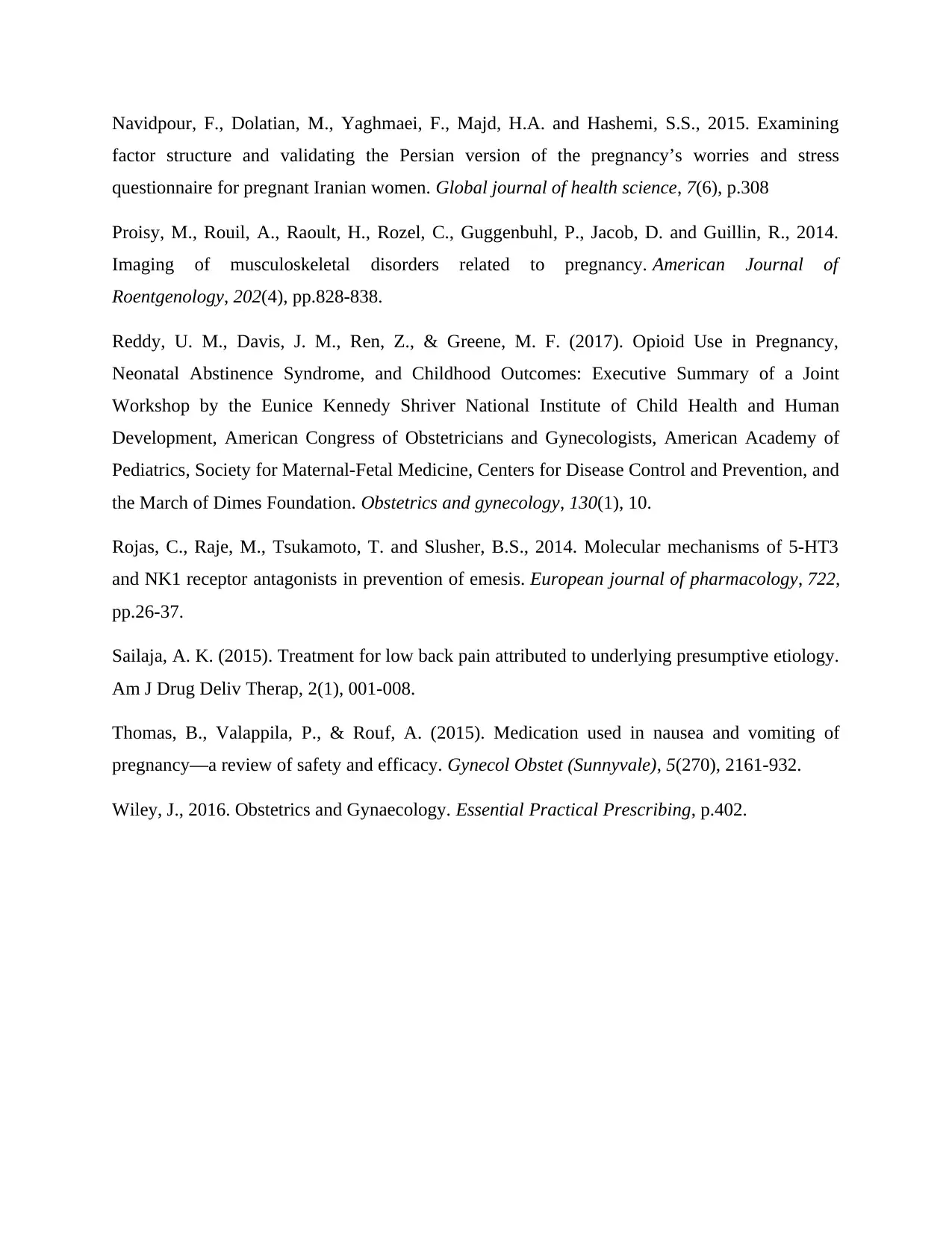
Navidpour, F., Dolatian, M., Yaghmaei, F., Majd, H.A. and Hashemi, S.S., 2015. Examining
factor structure and validating the Persian version of the pregnancy’s worries and stress
questionnaire for pregnant Iranian women. Global journal of health science, 7(6), p.308
Proisy, M., Rouil, A., Raoult, H., Rozel, C., Guggenbuhl, P., Jacob, D. and Guillin, R., 2014.
Imaging of musculoskeletal disorders related to pregnancy. American Journal of
Roentgenology, 202(4), pp.828-838.
Reddy, U. M., Davis, J. M., Ren, Z., & Greene, M. F. (2017). Opioid Use in Pregnancy,
Neonatal Abstinence Syndrome, and Childhood Outcomes: Executive Summary of a Joint
Workshop by the Eunice Kennedy Shriver National Institute of Child Health and Human
Development, American Congress of Obstetricians and Gynecologists, American Academy of
Pediatrics, Society for Maternal-Fetal Medicine, Centers for Disease Control and Prevention, and
the March of Dimes Foundation. Obstetrics and gynecology, 130(1), 10.
Rojas, C., Raje, M., Tsukamoto, T. and Slusher, B.S., 2014. Molecular mechanisms of 5-HT3
and NK1 receptor antagonists in prevention of emesis. European journal of pharmacology, 722,
pp.26-37.
Sailaja, A. K. (2015). Treatment for low back pain attributed to underlying presumptive etiology.
Am J Drug Deliv Therap, 2(1), 001-008.
Thomas, B., Valappila, P., & Rouf, A. (2015). Medication used in nausea and vomiting of
pregnancy—a review of safety and efficacy. Gynecol Obstet (Sunnyvale), 5(270), 2161-932.
Wiley, J., 2016. Obstetrics and Gynaecology. Essential Practical Prescribing, p.402.
factor structure and validating the Persian version of the pregnancy’s worries and stress
questionnaire for pregnant Iranian women. Global journal of health science, 7(6), p.308
Proisy, M., Rouil, A., Raoult, H., Rozel, C., Guggenbuhl, P., Jacob, D. and Guillin, R., 2014.
Imaging of musculoskeletal disorders related to pregnancy. American Journal of
Roentgenology, 202(4), pp.828-838.
Reddy, U. M., Davis, J. M., Ren, Z., & Greene, M. F. (2017). Opioid Use in Pregnancy,
Neonatal Abstinence Syndrome, and Childhood Outcomes: Executive Summary of a Joint
Workshop by the Eunice Kennedy Shriver National Institute of Child Health and Human
Development, American Congress of Obstetricians and Gynecologists, American Academy of
Pediatrics, Society for Maternal-Fetal Medicine, Centers for Disease Control and Prevention, and
the March of Dimes Foundation. Obstetrics and gynecology, 130(1), 10.
Rojas, C., Raje, M., Tsukamoto, T. and Slusher, B.S., 2014. Molecular mechanisms of 5-HT3
and NK1 receptor antagonists in prevention of emesis. European journal of pharmacology, 722,
pp.26-37.
Sailaja, A. K. (2015). Treatment for low back pain attributed to underlying presumptive etiology.
Am J Drug Deliv Therap, 2(1), 001-008.
Thomas, B., Valappila, P., & Rouf, A. (2015). Medication used in nausea and vomiting of
pregnancy—a review of safety and efficacy. Gynecol Obstet (Sunnyvale), 5(270), 2161-932.
Wiley, J., 2016. Obstetrics and Gynaecology. Essential Practical Prescribing, p.402.
1 out of 8
Related Documents
Your All-in-One AI-Powered Toolkit for Academic Success.
+13062052269
info@desklib.com
Available 24*7 on WhatsApp / Email
![[object Object]](/_next/static/media/star-bottom.7253800d.svg)
Unlock your academic potential
Copyright © 2020–2025 A2Z Services. All Rights Reserved. Developed and managed by ZUCOL.



